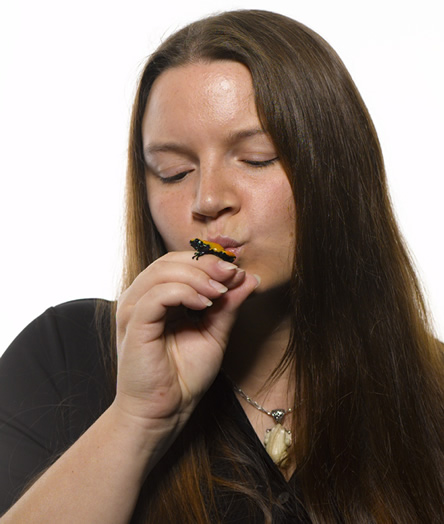Professionally...
I am doctoral student aiming
to eventually lead my own laboratory of amphibian chemical ecology. I am primarily
interested in the ecology and evolution of chemical defense in amphibians.
What is it in the amphibian secretions that make them repulsive to predators?
In the case of each amphibian species, is it peptides, alkaloids, quinones,
or other chemicals that defend them against predators and parasites? Or is
it some combination thereof?
Are the defensive chemicals made by the frogs, or do they eat toxic prey to
acquire the toxins for their own use? That is, where do the defensive chemicals
come from?
I have led two research/collecting expeditions to Madagascar (2003, 2007-8),
where I formed a team and we together collected hundreds of ants, millipedes,
beetles, and other arthropods. On the first expedition, three of the ants
had certain defensive alkaloid chemicals that also were found in frogs from
the same locale. Two of these three ants were recovered from the stomachs
of those frogs. This is convincing evidence that some of the alkaloid chemicals
are acquired from dietary ants. Also one of the millipedes we collected had
defensive chemicals (again alkaloids) in common with frogs.More recently,
on an expedition sponsored by the National Geographic Society, I taste tested
the Malagasy poison frogs to get a measure of toxicity… and am writing
up these results, which have important implications for the evolution and
ecology of these frogs.
Training-wise, I started under the mentorship of the
late Master of frog alkaloids—molecular pharmacologist Dr. John W. Daly
of the National Institutes of Health. He passed away from pancreatic cancer
in March 2008. His training was fundamental to developing my skills in the
lab. I then did my Master’s in Chemistry at Columbia and Cornell Universities,
studying under retired but very wise and knowledgeable legends of the fields
of Natural Products Chemistry and Chemical Ecology (Koji Nakanishi and Jerrold
Meinwald). Now I am conducting doctoral research with the younger but very
productive group of Chris Shaw at Queen’s University in Belfast, Northern
Ireland. Shaw’s group focuses on the identification and pharmacology
of frog peptides. We are already making some novel finds in the laboratory
that should prove of great importance for understanding the ecology and evolution
of chemical defense and communication in various amphibians.
On a more personal note...
As a child in the suburbs of Maryland, USA, our home was surrounded by several State Parks that I visited nearly every day. I was mesmerized with metamorphosis of tadpoles into frogs, started keeping them as pets, and like the tadpoles, I too was transformed—into one who lives for love of frogs. The variety of forms, patterns, colors, reproductive strategies, and habitats of frogs is most impressive, in addition to the fascinating chemistry of their skin secretions. I have a lot of frogs that are favorites, but the single most touching individual frog was a tepui tree toad I encountered in Guyana—this Oreophrynella sp. individual was a gravid female, and watching her touched my heart (see photo of her on main page!). In general I very much like colorful poison frogs and tree frogs with interesting behaviors, especially fascinated by those that have parental care of young in nests, pouches, etc. The Mantella poison frogs of Madagascar are of course one of my favorite genera, and deserve attention for their beauty as is received by other endemics such as chameleons and lemurs.
Ok, ok... but why do you lick frogs? Is that not dangerous, crazy, and potentially deadly??
Don't try this at home-- this is potentially deadly but I am well trained, and even so this could kill me if not careful, especially in some of the relatively unexplored rainforest that I visit!!! I started kissing frogs as a little girl but actually licking for scientific purposes was inspired by late mentor John Daly who used and published results using the licking technique, most recently in Thailand (2004 publication). The advantage is that a quick lick instantly informs you whether the frog is likely toxic to potential predators, and if it is, this would be due to some chemical that is biologically active, and therefore the identity of the chemical(s) should be determined. If I lick a frog with no taste or one that causes no sensations such as burning, numbness, pain, euphoria, etc., then that frog is not a priority for analysis. With so many frogs to analyze, this shortcut clues me in to those with the most potential to contain defensive chemicals and thus invite further investigation.

At the HeadQuarters of the National Geographic Society in Washington DC, I
kissed and licked frogs for an article that appeared in the November 2008
issue of National Geographic Magazine. Click here for PHOTOS
of me in Madagascar!
Photo courtesy of the National Geographic Society, by staff photographer Becky Hale, taken on May 29, 2008.
Back to top of this page OR Return to Home of Valerie C. Clark
